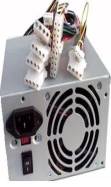|
|
![]() |
|
Cover Page | Core Components | Storage Devices | Cards | Connectors | Peripherals |
| Optional Peripherals & Common PC Specs
| Computer Glossary | Order More Books
|

Internal & External
Connectors & Ports
INTERNAL
Internal ports and connectors are located
inside of the PC case, on the Motherboard (see motherboard
diagram).
The power supply supplies voltage to the
motherboard via the P1 or P8-P9 connector on the power supply
The power supply sends voltage to the storage
devices via its molex and mini connectors.
Use the submini connectors on the power
supply to give voltage to the CPU fan.

- From the outside of the PC case, you can locate the power
supply by finding the black power switch. Another indicator that you have located the
power supply, it has one or two, three-prong power supply cord connections and a
built-in fan, allowing air to be exhausted from the back of the PC.
Adapters and Dongles
If there is no USB port, install a USB dongle
on the inside of your computer. Dongles have ribbon cables that have to be connected onto
the motherboard. Usually there will be a written indication on the motherboard to
tell you where the dongle's ribbon cable can be plugged. 
Some dongles will allow you to convert your
older computer to be able to use a PS/2 mouse and a more modern keyboard.
Most older computers lack the connectors for
newer devices, like a PS/2 mouse or a USB port.
If there is not a connection from your
computer for a particular device, you have to install or attach adapters and dongles.
These internal adapters and power supply
connectors are visible from the back (and sometimes front) of the PC case.
EXTERNAL
External ports and connectors are located on
the outside of the PC case.

The outside of the PC case provides ports
that support external components, like a printer, mouse, keyboard, speakers,
microphone, earplug, joystick and serial (usually a serial mouse) and USB devices
(usually a USB digital camera, USB printer or USB mouse or keyboard).
The ports are built into the motherboard and
extend to the outside of the PC case.
There are three types of mouse: serial, USB
and PS/2. If the PS/2 connector is missing, you have to attach a PS/2 adapter, which is
attached to the mouse, then attached to the outside of the PC case.

A Few Names of Ports and Connectors
PS/2 port (for some mouses and some
keyboards)
USB port (for USB devices)
Serial ports and DB connectors (for
joysticks, printers, some mouses and serial devices)
Parallel port (for printers)
Onboard controller port (for all storage
devices)
Please refer to the PC
Glossary for more information.
|
Understanding PC Hardware, Second Edition, ©2003
Cary Muhammad, (All Rights Reserved), vipcomputers4u@yahoo.com |
